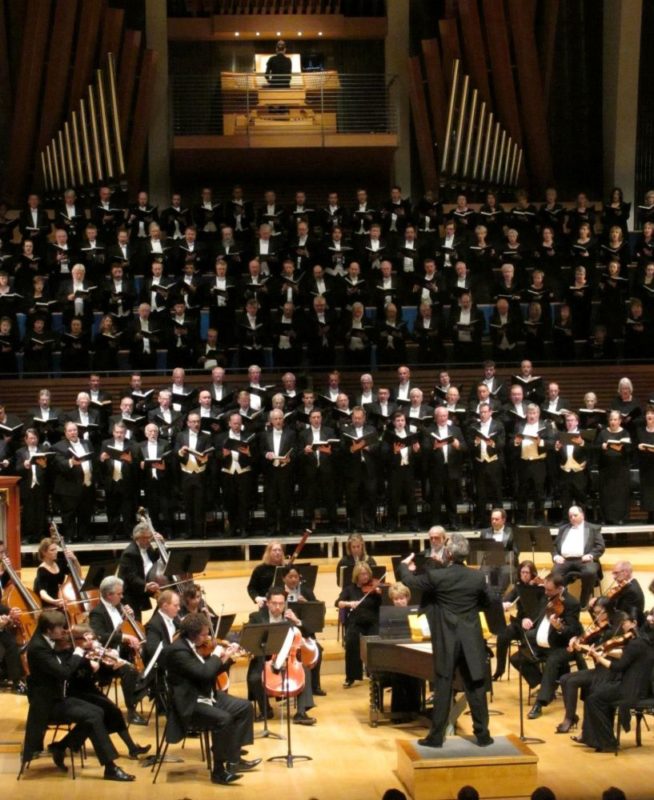by Karen Hauge
KCMetropolis.org
I am aware that it is considered fashionable in elite musical circles to disdain certain pieces of music as overused, overplayed, and not deserving of the centuries of air time they have received. Handel’s oratorio Messiah is certainly one of those pieces, and while I have to agree that the “Hallelujah” chorus has been abused for the sake of a few too many TV commercials, the fact remains that Messiah is truly a masterwork of the choral and vocal repertoire, and I’m not ashamed to say that I was as giddy as a child on Christmas morning as I settled into my seat for my first Kansas City Messiah experience.
The orchestra achieved a Baroque-esque sound on their modern instruments, in diminished numbers and an ensemble that paid homage to Handel’s original orchestra score: strings, two oboes, bassoon, two trumpets, timpani, two organs, and harpsichord. In the beginning “Sinfonia” the orchestra played with appropriately sparing vibrato and a well-balanced sound that was agile and tight throughout the counterpoint. Later in Part I during the second solo orchestra movement, “Pifa,” the group executed ensemble embellishments in delightfully perfect unison, and each time the practice was repeated throughout the night it recalled the aesthetic of a Baroque orchestra. Praise is certainly owed to oboists Kristina Goettler and Kenneth Lawrence, whose bright articulation and clear sound led the way for many of the complicated choral passages.
Tenor Ross Hauck, fresh from recording this very piece with Apollo’s Fire last year, brought warmth and color to “Comfort ye my people,” the second piece of Part I, and the following air “Ev’ry valley shall be exalted” showed lovely blend throughout his range as well a clever and personality-filled delivery of the florid, active line. Kevin Deas’s bass sound was that magical combination of rich, clear, and full that projected well without compromising the quality of a single note, no matter how low or how brief. His first solo piece, “Thus saith the Lord,” was dramatic and powerful, especially when contrasted with the slower “But who may abide” which followed. But it was Part III’s “The trumpet shall sound” which was the highlight of Deas’s performance. Singing from memory, Deas used straight tone to great effect in order to imitate the sound of the trumpet, and executed the grandiose over-dotted rhythms handily. Gary Schutza’s trumpet was suitably glorious with long-breathed lines and crisp, round articulation, becoming the de facto leader of the orchestra as he alternated between a duet with Deas and the eminent voice in the orchestra, even introducing embellishments on the da capo that the orchestra had to imitate.
Alto Kirsten Sollek used her dark sound and crisp diction to be a powerfully emotive storyteller, especially during “He was despised” as Sollek interspersed delicious straight-tone with her resonant sound to create a sense of vulnerability, and then exploded into the fiery second part of the aria with electrifying, surprising energy. Expressiveness was soprano Ava Pine’s most valuable asset throughout her solo performances, especially her gorgeous storytelling of “There were shepherds” which led into the triumphant “Glory to God!” chorus. Pine’s emotional palette and vocal control allowed her to shift from light and coquettish one moment to tender and passionate another, all with highly compelling expression that drew the audience into the story.
I was initially concerned about the chorus movements, since the first few on the program were shakily executed; indeed, “And He shall purify” saw the orchestra chorus separated by a whole beat for about a measure before coordination was regained. This movement and a few other of the Part I choruses suffered from similar issues, with weaker sound on fast running passages leading to a muddy sound and loss of pulse rather than Handel’s intended crisp counterpoint. However, after these moments of disrepair and uncertainty in Part I, the choir seemed to get better and better as they went, with each of the following choruses stronger than the last.
One of the strongest moments of the evening was the long first scene of Part II. Nine pieces are connected by a common story through the text, and the attacca presentation of the pieces during the performance created a wonderfully threaded story. “Surely he hath borne our griefs”/ “And with his stripes” was the best the choir had sounded so far in the evening, creating a beautifully dark sound that not only matched the serious text but also demonstrated an improvement from earlier choruses with its great balance and fullness.
I was sure, as we approached the end of Part II, that I would be the only nerd in the audience to rise excitedly to my feet in keeping with a centuries-old tradition, so you can imagine my delight when the sold-out crowd in Helzberg Hall all stood at the sounding of the familiar opening strains of the “Hallelujah” chorus. The beloved movement was beautifully performed, with the choir executing the complex lines with strong clarity and the orchestra’s agile performance supported by the power of the Casavant organ and joyful timpani and trumpet.
The popularity of “Hallelujah” has led many to assume that it is not only the greatest chorus of Messiah, but also the final one. Alas! A whole Part III follows it, and whether the final chorus “Worthy is the Lamb”/ “Amen” is greater than any other chorus in the piece is up to personal opinion, but I can say for myself that the complexity, grandeur, and emotional triumph of this finale won my heart long ago, and the Kansas City Symphony et al. did not disappoint. Soaring melodies, carefully woven choral lines, and full-for-its-time orchestration brought the night of oratorio to an exhilarating close that satisfied the excitement I always feel when I listen to this true masterpiece.



